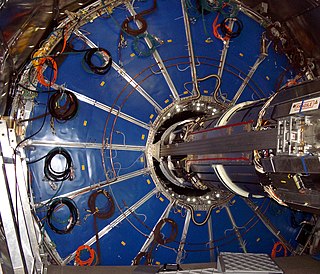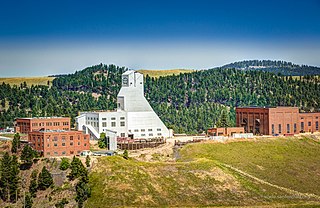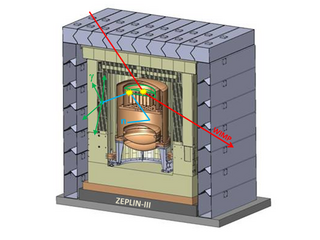Weakly interacting massive particles (WIMPs) are hypothetical particles that are one of the proposed candidates for dark matter.

In physics, a time projection chamber (TPC) is a type of particle detector that uses a combination of electric fields and magnetic fields together with a sensitive volume of gas or liquid to perform a three-dimensional reconstruction of a particle trajectory or interaction.
The Cryogenic Dark Matter Search (CDMS) is a series of experiments designed to directly detect particle dark matter in the form of Weakly Interacting Massive Particles. Using an array of semiconductor detectors at millikelvin temperatures, CDMS has at times set the most sensitive limits on the interactions of WIMP dark matter with terrestrial materials. The first experiment, CDMS I, was run in a tunnel under the Stanford University campus. It was followed by CDMS II experiment in the Soudan Mine. The most recent experiment, SuperCDMS, was located deep underground in the Soudan Mine in northern Minnesota and collected data from 2011 through 2015. The series of experiments continues with SuperCDMS SNOLAB, an experiment located at the SNOLAB facility near Sudbury, Ontario in Canada that started construction in 2018 and is expected to start data taking in early 2020s.
The XENON dark matter research project, operated at the Italian Gran Sasso National Laboratory, is a deep underground detector facility featuring increasingly ambitious experiments aiming to detect hypothetical dark matter particles. The experiments aim to detect particles in the form of weakly interacting massive particles (WIMPs) by looking for rare nuclear recoil interactions in a liquid xenon target chamber. The current detector consists of a dual phase time projection chamber (TPC).

The UK Dark Matter Collaboration (UKDMC) (1987–2007) was an experiment to search for Weakly interacting massive particles (WIMPs). The consortium consisted of astrophysicists and particle physicists from the United Kingdom, who conducted experiments with the ultimate goal of detecting rare scattering events which would occur if galactic dark matter consists largely of a new heavy neutral particle. Detectors were set up 1,100 m (3,600 ft) underground in a halite seam at the Boulby Mine in North Yorkshire.
The ArDM Experiment was a particle physics experiment based on a liquid argon detector, aiming at measuring signals from WIMPs, which may constitute the Dark Matter in the universe. Elastic scattering of WIMPs from argon nuclei is measurable by observing free electrons from ionization and photons from scintillation, which are produced by the recoiling nucleus interacting with neighbouring atoms. The ionization and scintillation signals can be measured with dedicated readout techniques, which constituted a fundamental part of the detector.

DEAP is a direct dark matter search experiment which uses liquid argon as a target material. DEAP utilizes background discrimination based on the characteristic scintillation pulse-shape of argon. A first-generation detector (DEAP-1) with a 7 kg target mass was operated at Queen's University to test the performance of pulse-shape discrimination at low recoil energies in liquid argon. DEAP-1 was then moved to SNOLAB, 2 km below Earth's surface, in October 2007 and collected data into 2011.

The Sanford Underground Research Facility (SURF), or Sanford Lab, is an underground laboratory in Lead, South Dakota. The deepest underground laboratory in the United States, it houses multiple experiments in areas such as dark matter and neutrino physics research, biology, geology and engineering. There are currently 28 active research projects housed within the facility.

The European Underground Rare Event Calorimeter Array (EURECA) is a planned dark matter search experiment using cryogenic detectors and an absorber mass of up to 1 tonne. The project will be built in the Modane Underground Laboratory and will bring together researchers working on the CRESST and EDELWEISS experiments.

EDELWEISS is a dark matter search experiment located at the Modane Underground Laboratory in France. The experiment uses cryogenic detectors, measuring both the phonon and ionization signals produced by particle interactions in germanium crystals. This technique allows nuclear recoils events to be distinguished from electron recoil events.
The DarkSide collaboration is an international affiliation of universities and labs seeking to directly detect dark matter in the form of weakly interacting massive particles (WIMPs). The collaboration is planning, building and operating a series of liquid argon time projection chambers (TPCs) that are employed at the Gran Sasso National Laboratory in Assergi, Italy. The detectors are filled with liquid argon from underground sources in order to exclude the radioactive isotope 39
Ar, which makes up one in every 1015 (quadrillion) atoms in atmospheric argon. The Darkside-10 (DS-10) prototype was tested in 2012, and the Darkside-50 (DS-50) experiment has been operating since 2013. Darkside-20k (DS-20k) with 20 tonnes of liquid argon is being planned as of 2019.

The ZEPLIN-III dark matter experiment attempted to detect galactic WIMPs using a 12 kg liquid xenon target. It operated from 2006 to 2011 at the Boulby Underground Laboratory in Loftus, North Yorkshire. This was the last in a series of xenon-based experiments in the ZEPLIN programme pursued originally by the UK Dark Matter Collaboration (UKDMC). The ZEPLIN-III project was led by Imperial College London and also included the Rutherford Appleton Laboratory and the University of Edinburgh in the UK, as well as LIP-Coimbra in Portugal and ITEP-Moscow in Russia. It ruled out cross-sections for elastic scattering of WIMPs off nucleons above 3.9 × 10−8 pb from the two science runs conducted at Boulby.
Richard Jeremy Gaitskell is a physicist and professor at Brown University and a leading scientist in the search for particle dark matter. He is co-founder, a principal investigator, and co-spokesperson of the Large Underground Xenon (LUX) experiment, which announced world-leading first results on October 30, 2013. He is also a leading investigator in the new LUX-Zeplin (LZ) dark matter experiment.
The Particle and Astrophysical Xenon Detector, or PandaX, is a dark matter detection experiment at China Jinping Underground Laboratory (CJPL) in Sichuan, China. The experiment occupies the deepest underground laboratory in the world, and is among the largest of its kind.
The Cryogenic Low-Energy Astrophysics with Noble liquids (CLEAN) experiment by the DEAP/CLEAN collaboration is searching for dark matter using noble gases at the SNOLAB underground facility. CLEAN has studied neon and argon in the MicroCLEAN prototype, and running the MiniCLEAN detector to test a multi-ton design.

The LUX-ZEPLIN (LZ) Experiment is a next-generation dark matter direct detection experiment hoping to observe weakly interacting massive particles (WIMP) scatters on nuclei. It was formed in 2012 by combining the LUX and ZEPLIN groups. It is currently a collaboration of 30 institutes in the US, UK, Portugal and South Korea. The experiment is located at the Sanford Underground Research Facility (SURF) in South Dakota, and is managed by the United States Department of Energy's (DOE) Lawrence Berkeley National Lab.
Daniel Nicholas McKinsey is an American experimental physicist. McKinsey is a leader in the field of direct searches for dark matter interactions, and serves as Co-Spokesperson of the Large Underground Xenon experiment. and is an executive committee member of the LUX-ZEPLIN experiment. He serves as Director and Principal Investigator of the TESSERACT Project, and is also The Georgia Lee Distinguished Professor of Physics at the University of California, Berkeley.
Direct detection of dark matter is the science of attempting to directly measure dark matter collisions in Earth-based experiments. Modern astrophysical measurements, such as from the Cosmic Microwave Background, strongly indicate that 85% of the matter content of the universe is unaccounted for. Although the existence of dark matter is widely believed, what form it takes or its precise properties has never been determined. There are three main avenues of research to detect dark matter: attempts to make dark matter in accelerators, indirect detection of dark matter annihilation, and direct detection of dark matter in terrestrial labs. The founding principle of direct dark matter detection is that since dark matter is known to exist in the local universe, as the Earth, Solar System, and the Milky Way Galaxy carve out a path through the universe they must intercept dark matter, regardless of what form it takes.
Daniel S. Akerib is an American particle physicist and astrophysicist. He was elected in 2008 a fellow of the American Physical Society (APS).
Alvine Kamaha is a Cameroonian-born assistant professor of physics at the University of California, Los Angeles (UCLA).












